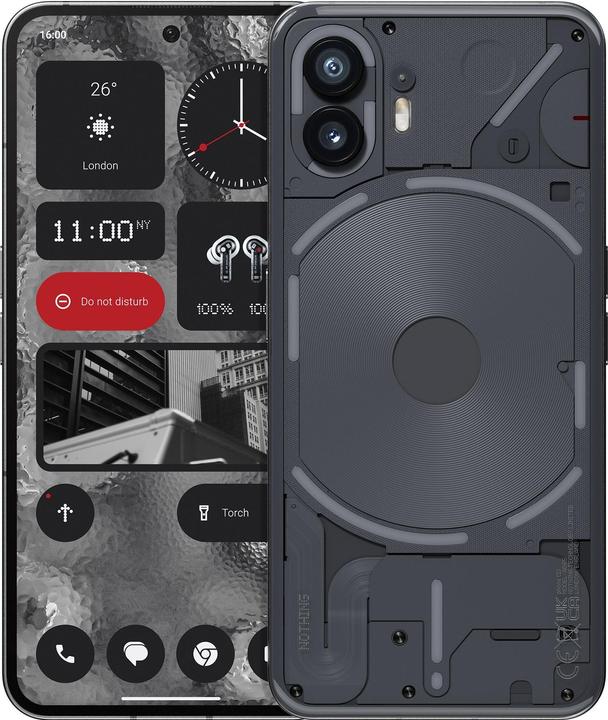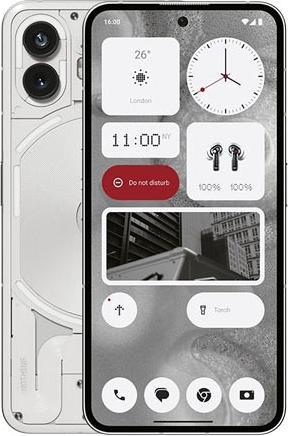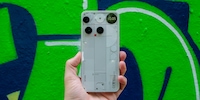

Nothing Phone (2) review – not the best phone, but the coolest one!
The manufacturer Nothing has improved a lot in the Phone (2) compared to the previous version. It packs more power and a longer battery life – and the Glyph back now sports eleven LEDs.
The Nothing Phone (2) differs from other Android smartphones mainly in its design, which features LEDs on the back. The «Glyph Interface» is made up of more elements that the predecessor. And Nothing has also taken a step towards the mid to upper range in terms of hardware.

Small tweaks to the design
Nothing has only made minor adjustments to the design of the Phone (2), which only become apparent upon closer inspection.
The transparent back has remained, its edges are now slightly rounded. There are slight shifts in the elements it houses, the most striking change being that the Glyph Interface now comprises eleven LEDs. In the previous model, there were just five. The frame is, again, made of aluminium – this time around, 100% recycled. The cutout for the front-facing camera has been moved to the centre to create more symmetry.
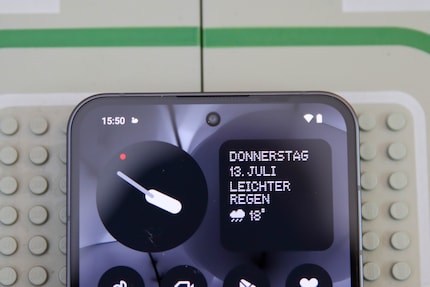
Source: Jan Johannsen
Despite the few changes in the Phone (2), it still stands out with its design. It’s novel and cool – but the effect could wear off over time. It’ll take more significant changes to keep it interesting.
At 6.7 inches, the Phone (2)’s OLED display is slightly larger than the predecessor’s. It displays a sharp and detailed image with a resolution of 2412 × 1080 pixels. The colours shine with up to 1,000 nits, making the phone perfectly usable in the sunshine. The refresh rate of up to 120 hertz dynamically adapts to the screen content, or you can set it permanently to 60 or 120 hertz.
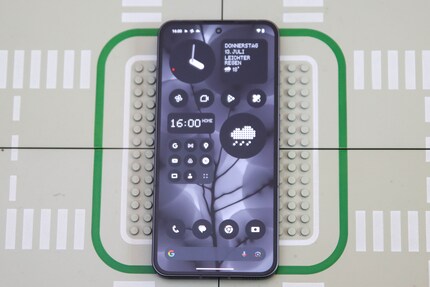
Source: Jan Johannsen
Nothing OS sets it apart from other Android smartphones
Nothing doesn’t only try to stand out from the Android competition in terms of hardware design, but also with its proprietary user interface, Nothing OS 2.0. It introduces some exclusive features to Android 13 as well as new design options. Nothing promises to provide three years of Android updates and four years of security updates for the Phone (2).
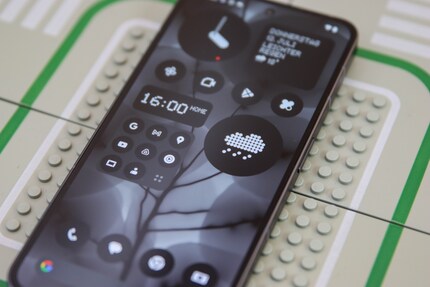
Source: Jan Johannsen
Among other options, you can select a monochrome look. At first glance, it has a relaxing, minimalist vibe. Unfortunately, not all app logos follow the monochrome look yet, so a bit of colour breaks through in certain areas. And once you leave the home screen, all colour reappears. I find this back-and-forth more exhausting than permanently seeing colourful app logos.
Lock screen widgets
The idea of widgets on the lock screen sounded like a very practical thing to me at first. But there are limitations: for one, the only widgets currently available are a clock, weather info and quick settings. Now, displaying the weather and time is standard on virtually all phones. So, the only real innovation is the quick settings. For example, I can conveniently turn the flashlight on and off or activate Nearby Share. However, certain quick settings require you to unlock the phone, making it rather superfluous to have them on the lock screen.
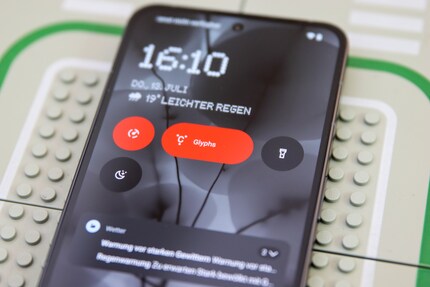
Source: Jan Johannsen
At the end of the day, I’m less excited about the widgets on the lock screen than I’d expected to be. Mind you, they are still handy and I’m curious how Nothing will develop them.
Glyph Interface: playing with LEDs
Another feature of Nothing OS is the customisable LEDs on the back of the Phone (2). For example, you can set a Glyph timer. An LED will then gradually turns dark, indicating how much time remains. The same principle is planned for use with Glyph Progress, a feature meant to show you the status of a delivery, for example. This feature is still in the testing phase and only works with Uber cars.
More musically creative people than I might be pleased with the so-called Glyph Composer. Currently, five sound libraries are available with five sounds each. The selection ranges from reverberating electric organ sounds to modem noises to various drum sounds. You can use them to create your own sound and light sequences and assign them to contacts and apps. Of course, you can also do so using the sounds specified by Nothing. I’m inclined to set a default tone and assign a few of my closest people their own tones. I don’t want to have to remember too many different combinations of sound and person.
More power than the weak predecessor
Improving the performance of the Phone (2) compared to its predecessor was an easy task for Nothing. The Phone (1) had the mid-range Snapdragon 778G+ chipset. The Phone (2) now features the Snapdragon 8+ Gen 1, one of the top chips from 2022.
The Phone (2) clearly outperforms its predecessor in the Geekbench 6 benchmark test. Even the Xiaomi 12T Pro with the same chipset clearly lags behind the Phone (2). Only the newer Snapdragon 8 Gen 2 achieves better results in various smartphones. Below is a comparison with the Moto Edge 40 Pro.
Longer battery life thanks to new chipset
Nothing has slightly increased the battery capacity of the Phone (2) by 200 mAh up to 4,700 mAh. The Battery test from PCMark measures a runtime that’s longer by over one and a half hours, with the processor’s lower power consumption making itself felt.
The Phone (2) can charge with up to 45 watts. The phone doesn’t come with a power adapter, but Nothing offers one separately. It’s supposed to fully charge the phone in 55 minutes.
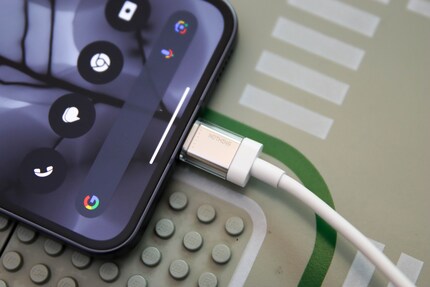
Source: Jan Johannsen
The phone also supports wireless charging with up to 15 watts, in which case a full charge is supposed to take 130 minutes. You can also use the Phone (2) to charge other gadgets wirelessly at a maximum of five watts – for example, the Nothing Ear (2).
Improved processing instead of a new camera
The Nothing Phone (2) still has two cameras with a resolution of 50 megapixels each. The main camera offers some small changes compared to the predecessor. The ultra-wide-angle camera is the same as in the Phone (1). Nothing attributes improvements in image quality first and foremost to the new processor. The Snapdragon 8+ Gen 1 is supposed to capture more data and offer better post-processing capabilities.
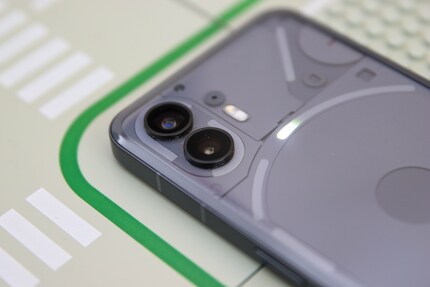
Source: Jan Johannsen
Main camera
Nothing now uses the Sony IMX890 as the Phone (2)’s main camera, which is also found in the OnePlus Nord 3, for example. In the Phone (1), it was the Sony IMX766. Despite the large jump in the sensor’s name, the differences are actually minimal on paper. The resolution (50 megapixels), focal length (24 mm), sensor size (1/1.56 inch) and pixel size (1 µm) are identical. Only the aperture has changed minimally from f/1.9 to f/1.88 on the Phone (2). Due to pixel binning, the photos have a resolution of 12.5 megapixels by default. You can switch the full 50 megapixels in the settings, though not in every mode or function.
I’m very satisfied with the detail and colour reproduction of the main camera. Even strong contrasts don’t cause problems.

Source: Jan Johannsen
Compared with the Nothing Phone (1), there are some minor details in colour reproduction. Initially, I prefer the Phone (2)’s colours, and especially the black. Over time, though, I start to wonder if the effect isn’t achieved by upping the yellow somewhat excessively. In terms of detail, I see no difference between the two phones.
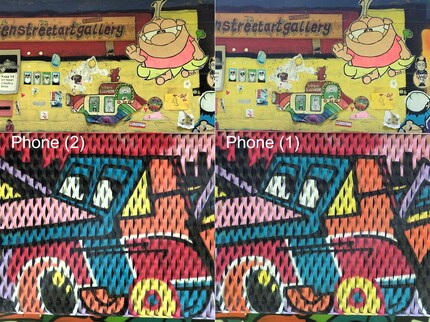
Source: Jan Johannsen
The Nothing Phone (2) has no telephoto lens. Zooming is done digitally with the main camera, up to a maximum of 10x. With the predecessor, it was 20x. Given the poor quality achieved with the 20x zoom, this reduction isn’t a negative.
The 2x zoom takes advantage of the sensor’s high resolution to, in essence, digitally zoom in on it. The result looks decent on the smartphone’s display. Viewed in full resolution on the computer, however, shortcomings in the level of detail become noticeable.

Source: Jan Johannsen
The 10x zoom is an entirely digital enlargement, that is, a section of the photo, and is useless.

Source: Jan Johannsen
I don't see any difference in terms of quality, but I do notice differences in colour. I prefer those on the Phone (2):
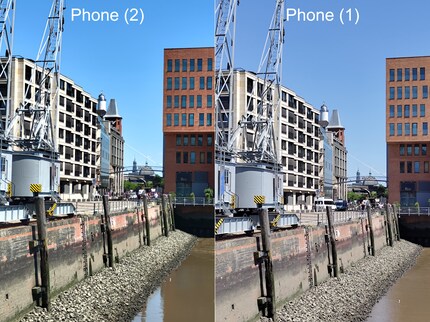
Source: Jan Johannsen
The Phone (2) clearly also delivers superior colours in portrait mode. Especially my black t-shirt doesn’t look so faded.
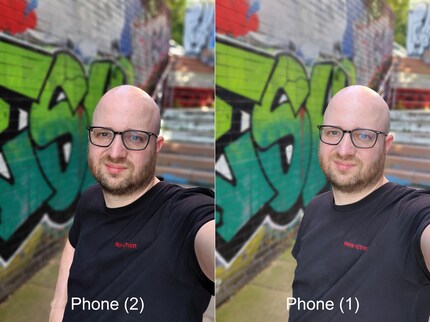
Source: Jan Johannsen
I look neatly delineated from the background, an effect that seems to depend on where the photo is taken. The scene in the following picture is much brighter and my head is cut out less precisely.

Source: Jan Johannsen
Ultra-wide-angle camera
The ultra-wide-angle camera on the Phone (2) remains unchanged compared to the Phone (1). The sensor used is the 1/2.76-inch Samsung Isocell JN1 with an aperture of f/2.2 and a field of view of 114 degrees.
It’s enough to give you high-detail shots. The software does a good job of removing distortions around the edges. This is changes in colour are the most obvious. Overall, I like the photos taken on the Phone (2) a lot more.

Source: Jan Johannsen

Source: Jan Johannsen
Nothing also relies on the Phone (2)’s ultra-wide-angle lens for macro shots. In doing so, the software only accesses part of the sensor to get closer to the subject. The recommended distance for taking macro shots is 4 cm. However, the results don’t really tempt me to take all that many close-up shots.

Source: Jan Johannsen
Night mode
The Phone (2) delivers usable, but not outstanding nighttime photos. They look decent on the phone’s display, with night mode delivering only slight differences.
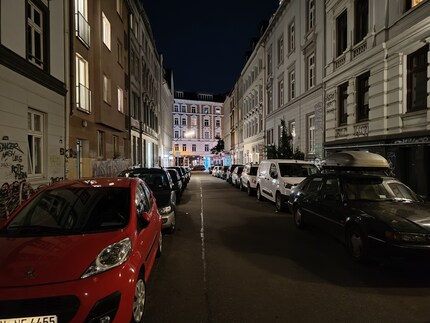
Source: Jan Johannsen
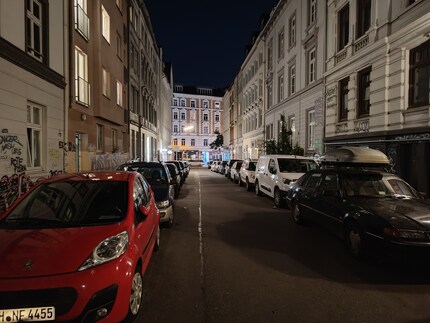
Source: Jan Johannsen
The differences remain minimal even when viewed in their original size on the PC. Compared with the Phone (1), however, the differences are greater. You can really see the Phone (2)’s strengths – take a look at the light coming from the street lamp and the details of the stucco elements on the houses.
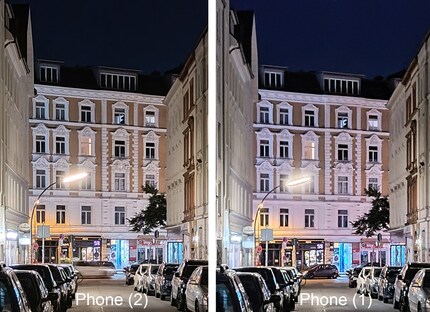
Source: Jan Johannsen
Selfies
Nothing has not only moved the front camera in the Phone (2) to the centre of the front, but also doubled its resolution. The image sensor installed is the Sony IMX615. Its aperture of f/2.45 lets in less light than the rear cameras.
I’m very satisfied with the selfies in daylight. The improved post-processing by the Snapdragon 8+ Gen 1 compared with the Phone (1) can also be seen in the colour. The new sensor also ensures a slightly higher level of detail.

Source: Jan Johannsen

Source: Jan Johannsen
In the dark, the selfies taken with the Phone (2) offer a higher level of detail than those taken with the Phone (1). But they’re still not what I’d call «good». The increased brightness doesn’t save them. There’s also a blatant red cast, which isn’t there on the Phone (1).

Source: Jan Johannsen

Source: Jan Johannsen
How long will the design’s novelty factor remain?
The Nothing Phone (2) is not the best phone, but it is the coolest one. It has a unique design that makes even its second generation an eye-catcher – though I admittedly don’t use the Glyph Interface as much as I could. It’s also fun to keep discovering new details in the design, such as the SIM removal tool and the watch hands.
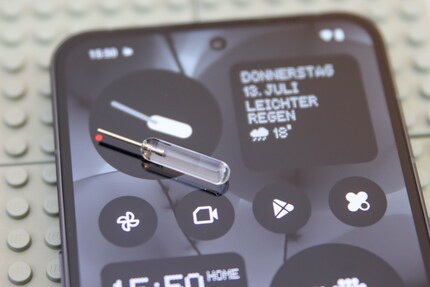
Source: Jan Johannsen
The real question is when will the novelty wear off. When will Nothing have to change up its design to keep the coolness factor?
Compared to the Phone (1), the Phone (2) has improved, as you’d expect. It’s got a bit more battery performance, a bit better image quality, and significantly more computing power. All in all, it’s a very good second-tier smartphone. Price-wise, the Phone (2) is about 200 euros or francs more expensive than the Phone (1), but still a ways off four figures.
Mind you, there’s some quality competition without LEDs on the back within the same price range. The Galaxy S23 and Motorola Moto Edge 40 Pro spring to mind. In a nutshell, what sets the Nothing Phone (2) apart is its design and the Glyph Interface.
Header image: Jan JohannsenAs a primary school pupil, I used to sit in a friend's living room with many of my classmates to play the Super NES. Now I get my hands on the latest technology and test it for you. In recent years at Curved, Computer Bild and Netzwelt, now at Digitec and Galaxus.

